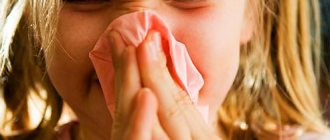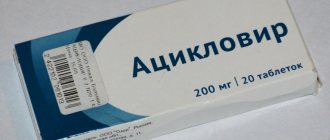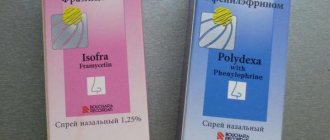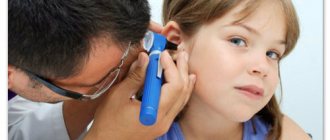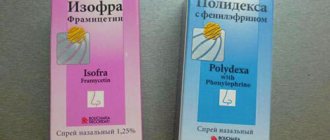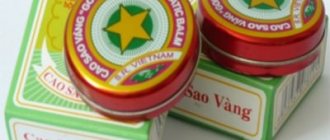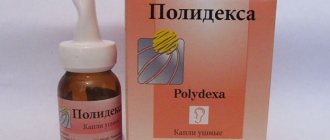"Isofra": instructions for use for children
"Isofra" for children is a medicine against bacterial inflammation of the nasal mucosa.
The drug is an antibiotic and is used only as prescribed by a doctor. The duration of treatment is recommended no more than 7 days, so as not to disturb the natural microflora of the nasopharynx. "Isofra" is classified as a local antibiotic. The drug cannot be prescribed for prophylactic purposes. Pediatricians do not recommend using it in the initial stages of viral infections of the upper respiratory tract, but add it to treatment when bacterial inflammation develops.
In what cases is Isofra prescribed?
"Isofra" is prescribed for inflammatory processes accompanied by swelling of the mucous membrane and purulent discharge. If a child's nasal discharge is not clear, but green or yellow, this is an indicator of the development of bacterial infections and a signal to use antibacterial agents.
When doctors prescribe Isofra:
- for sinusitis;
- rhinitis;
- rhinopharyngitis;
- as part of complex therapy for infectious and inflammatory diseases of the upper respiratory tract;
- prevention of inflammatory processes after surgical interventions.
Composition and release form
The active ingredient of the drug is framycetin sulfate, an antibiotic from the aminoglycoside group (this group is one of the first antibiotics). The drug is able to fight most gram-positive and gram-negative bacteria that cause infections of the upper respiratory tract. In addition to the active ingredient, the medicine contains methyl parahydroxybenzoate, sodium chloride, sodium citrate, citric acid monohydrate and purified water.
Isofra is available only in the form of a nasal spray.
Is Isofr possible for children: instructions for use
In the instructions for use, the manufacturer notes the possibility of using Isofra in children, but does not indicate the age at which use is permissible. At the same time, the contraindications include the period of breastfeeding, from which it can be assumed that the effect of the drug on the body of a child in infancy has not been fully studied, and the use of Isofra for up to a year is carried out with extreme caution.
The spray form of the medicine is not recommended for use in pediatrics for children under one year old; babies have sensitive mucous membranes, and administering the medicine under pressure can cause laryngospasm. Isofra's spray injects the medicine quite gently. In pediatrics, there are cases of prescribing this drug to children under one year old, although most doctors try to select other medications for babies: in the form of drops and with a composition more suitable for their age.
Directions for use and doses
For children, the medicine is prescribed one injection into each nostril 3 times a day. The bottle is held vertically when injecting.
Before injection, the child’s nose must be cleared of secretions. For the smallest children, clean their nose with a cotton swab. Older children wash their noses themselves and blow their noses.
special instructions
Contraindications to Isofra indicate that the medicine is not used in cases of hypersensitivity to framycetin and antibiotics from the aminoglycoside group. The drug is not intended for rinsing the paranasal sinuses.
The manufacturer indicates the possibility of allergic reactions to Isofra. In this case, the medicine is discontinued and replaced with another, more suitable one.
For viral infections, Isofra is not used for children; it only works against bacteria.
The drug is used only as prescribed by a doctor. It is not recommended to use it for longer than 7 days. When self-prescribing the drug and its uncontrolled use, the natural microflora of the child’s mucosa is disrupted.
Isofra for a runny nose: indications, instructions, reviews
The upper respiratory tract can sometimes be unable to cope with multiple infections.
In this case, the infection often remains on the nasal mucosa and paranasal sinuses, which can cause a runny nose and its complications. To save certain nosological forms of runny nose in children and adults, the drug Isofra was created. The instructions describe the drug as an antibacterial, used to treat inflammatory processes in the nasal cavity and paranasal sinuses. Isofra is a topical drug used directly in the nasal cavity.
Release form
Many consumers perceive Isofra as nasal drops. This opinion was formed because they are most often recommended for children, and they are usually prescribed nasal drops.
In fact, Isofra is a nasal spray that has a special dispenser, which ensures easy use and uniform spraying of substances in the nasal cavity.
Thanks to this, the antibiotic penetrates even into hard-to-reach places.
Parents tend to buy nasal drops to treat their children because they believe that they are safer and more convenient.
But each dosage form has its own advantages and disadvantages. Thus, it is often inconvenient to use drops, and it is impossible to dose them, because part of the solution flows back, and part goes into the larynx.
The instructions for Isofra describe the simple process of using the spray: you need to take the bottle vertically, insert the tip of the bottle into the nostril and press the dispenser. First you need to rinse and clean your nose.
Adults are supposed to use Isofra 4-6 times a day, making one press into each nostril. When treating children, the instructions specify a lower dosage: one injection 3 times a day.
Effect of the drug and indications for use
Isofra's instructions contain complete information about the pharmacological action of the drug, indications for use and the presence of possible side effects. However, studying this information on your own does not guarantee that the remedy will help. You should always consult a doctor, especially if children have illnesses, since it is impossible to make a diagnosis on your own without the necessary procedures.
The antibiotic is effective against many pathogenic microbes, including: staphylococci, some types of streptococci, Shigella, Klebsiella, Proteus, etc. When infected with treponema, anaerobic bacteria or certain types of streptococci, Isofra is ineffective.
The active ingredient in Isofra is framycetin. Its mechanism of action is penetration through membranes into the cells of pathogenic microorganisms and inhibition of protein synthesis in them, which ultimately contributes to the destruction of these cells.
The instructions consider the following situations in which Isofra is prescribed:
- acute and chronic rhinitis of a bacterial nature,
- sinusitis (if there are no violations of the integrity of the walls of the paranasal sinuses and nasal septum),
- nasopharyngitis.
Isofra is also used to prevent infection of the nasal cavity and sinuses after surgery.
Contraindications and side effects
The instructions for any drug are required to be read, and Isofra is no exception here, since although it is of local importance, it is an antibiotic.
There are absolute and relative contraindications for Isofra. The instructions list individual intolerance to the components of the drug, specifically framycetin, as absolute contraindications.
Relative contraindications are the period of pregnancy and lactation (during this time the drug is used only if the risk from its non-use exceeds the risk from its use), as well as a tendency to allergies.
Side effects are rare. Most often they relate to skin allergic reactions. An overdose of Isofra does not occur, since a very small amount of the substance enters the bloodstream from the nasal mucosa.
The instructions for use warn adults and children against long-term use of Isofra. If it is used for more than 10 days, the natural microflora (dysbacteriosis) of the nasopharynx may be disrupted. If there is no effect of treatment within a week, you need to stop using Isofra, pay attention to analogues, or reconsider the diagnosis.
Despite the fact that it is an antibacterial agent, Isofra is not used for rinsing for inflammation of the sinuses (sinusitis). The drug should not be used together with antifungal agents, as they may reduce the effect of the antibiotic.
Comparison with other drugs
Before purchasing medications, many people wonder whether there are more effective or cheaper analogues for the drug. It makes sense to look for an analogue if Isofra for some reason did not have the desired effect. If necessary, an otolaryngologist will consider which Isofra analogues can be used to treat runny nose in adults and children:
- One of the first to consider is an analogue similar in composition – Framinazine. It belongs to the same group of drugs, has a bactericidal effect and promotes the death of microorganisms that cause a runny nose, sinusitis or nasopharyngitis.
- Another option that can be used instead of Isofra is Bioparox. It is not an antibiotic, but has an anti-inflammatory effect and penetrates into remote parts of the respiratory tract. Bioparox is also used for throat diseases.
- Protargol can be considered as an analogue of Isofra. It has the same pharmacological effect on the body (successfully fights the runny nose and sinusitis), but has a fundamentally different composition, so it can be used in case of intolerance to the components of Isofra.
- Another analogue of Isofra in terms of its effect on the body is Vibrocil. It successfully copes with various types of rhinitis, but has quite a few contraindications: cardiovascular diseases, diabetes mellitus, atrophy of the nasal mucosa, angle-closure glaucoma, etc.
- It is often considered as an analogue of Polydex, but this drug contains two antibiotics that are effective against a larger group of microorganisms. Polydex also contains components that have vasoconstrictor, antihistamine and anti-inflammatory effects, so it can be prescribed for allergic reactions to other drugs. However, only a doctor can choose which drug will be effective in a particular case.
Efficiency
There are different reviews about Isofra spray - from the most enthusiastic to the sharply negative. In any case, it makes sense to talk about the effectiveness or ineffectiveness of a remedy only if it was prescribed by a doctor, and not when it was recommended by a neighbor or a kind woman from a pharmacy:
- The doctor prescribed Isofra drops for my son, they helped us get rid of a runny nose, although the discharge was already thick and green. But they had no effect on my nephew at all. Perhaps all his problems were due to allergies; now his sister constantly takes him to the sea, and that’s the only place they can escape.
- I decided to try Isofra, the pharmacy recommended it. In general, I didn’t expect any effect: neither warm nor cold. It felt like water was splashing. To cure a common runny nose, it is better to pay attention to analogues. Vibrocil helped me personally.
- Isofra helped my baby get rid of a persistent runny nose (they couldn’t get better for two weeks) in just two days. The doctor told me to treat myself for a week, not only with the spray, but also with previously prescribed drugs (Rinorin and Aquamaris), so we completed the course to the end, even though we had already fully recovered.
- I can say that Isofra is an effective drug, but my daughter and I were simply exhausted with the bottle. Firstly, it is simply impossible to hold a bottle vertically with a small child, since the baby is constantly spinning. And secondly, I don’t know how the dispenser is designed, but sometimes a stream comes out of it, like from a fire hose, sometimes a drop is barely squeezed out. I don't know, maybe it's just me who was so lucky.
Dr. Evgeniy Komarovsky will tell you how to deal with a runny nose in a child:
Source: https://stoprinit.ru/lechenie/izofra-pri-nasmorke-u-rebenka.html
Release form, components
The medication is produced in two dosage forms - spray and drops. More often, pharmacies have the drug in the form of a spray, since the manufacturer produces drops in smaller quantities. The spray is in a plastic opaque container with a spray nozzle in an amount of 15 ml.
The active ingredient is framycetin, which is an antibiotic of the aminoglycoside group. 100 ml of medication contains 1.25 g. Additional components have no medicinal properties: sodium citrate, purified citric acid, methylparaben, sodium chloride.
Isofra price (where to buy)
How much does Isofra cost in Moscow? In the capital, the price of a nasal spray is about 186 rubles. The cost of the drug in Russia is on average 170 rubles per 15 ml.
The price of nasal drops in Kyiv pharmacies is from 72 to 138 hryvnia. On average - 93 hryvnia.
- Online pharmacies in RussiaRussia
- Online pharmacies in UkraineUkraine
ZdravCity
- Isofra nasal spray.
1.25% 15ml Bouchard Laboratories/Sofartex RUB 340 order
Pharmacy Dialogue
- Isofra nasal spray (15ml bottle)Laboratoires Bouchara-Recordati
400 rub. order
show more
Pharmacy24
- Isofra 8000MO/ml 15 ml N1 spray Sofartex, France
127 UAH.order
pharmachologic effect
Isofra does not have a vasoconstrictor effect. When applied locally, the spray and drops are quickly absorbed by the mucous membrane and have an antimicrobial bactericidal effect. Suppresses the growth and division of pathological microorganisms that cause diseases. Effective for diseases of the upper respiratory tract caused by gram-positive and gram-negative flora, which are not sensitive to penicillin:
- staphylococci;
- Klebsiella;
- streptococci;
- proteas;
- shigella;
- pseudomonas;
- enterobacteria.
Instructions for use
Before starting the procedure, the nasal cavity is cleaned of crusts and mucous discharge. For maximum effect, you can first drip a vasoconstrictor drug (Xymelin, Naphthyzin) into the nose, and after 15 minutes Isofra. Before using the spray, you need to shake it, make several presses in the air so that the dispenser is filled with the product. Inject into each nostril once up to 3 times a day for up to 10 days. Drops are instilled into each nasal passage 1-2 to six times a day, but not more often than every 1.5-2 hours.
During pregnancy
There is no exact data on the harmful effects of the drug on the body of a pregnant woman and the fetus. Doctors prescribe a drug if it is impossible to replace it. During lactation, it is recommended to stop breastfeeding and express milk until the end of treatment.
In children
Despite the fact that Isofra is an antibiotic, you should not be afraid of it, since it is not absorbed into the systemic bloodstream and does not have a detrimental effect on organs. A group of scientists conducted an experiment on the use of the drug in newborns from 4 months to 1 year with purulent rhinitis and sinusitis. No side effects or complications were found in any of the children; a complete cure of the disease was observed on the 5th day.
There is no special form of the drug for children, so the standard one is prescribed. For infants under 12 months, the medication is prohibited. From 1 year, drops and spray are allowed. Before using the product, you need to rinse the nasal cavity, and then drop 1 drop into each passage or make one injection into each nostril. The duration of treatment is determined by the pediatrician.
How to properly inject
To get the maximum effect of the spray, you must first apply vasoconstrictor drops or sprays such as Naphthyzin, Galazolin, Xymelin 15-20 minutes beforehand.
When breathing becomes freer, try to clear the nasal passages by blowing your nose. Isofra spray is administered with the bottle in a strictly vertical position. The dispenser is first inserted into one nostril and one injection is made into the nose, then the same is repeated on the opposite side.
Do not make several injections at once. This artificially increases the dosage of the antibiotic and provokes side effects. The course of treatment with Isofra for sinusitis is no more than a week. If there is no improvement, the drug is discontinued and another one is prescribed.
Indications, restrictions for use
The drug is prescribed for diseases of the nasal cavity, against the background of acute respiratory viral infections and its complications, accompanied by thick green discharge, fever, and impaired nasal breathing. Indications are only pathologies of bacterial origin:
The medication is used as a prophylactic agent to prevent infection and inflammation after surgery on the nasal cavities. Contraindications include age under 12 months, intolerance to the aminoglycoside group or components of Isofra.
Side effects, interactions with other drugs, storage conditions
The drug extremely rarely causes side effects. They are manifested by a local allergic reaction - redness of the mucous membranes, burning sensation, itching in the nose or rashes on the skin. In this case, the use is stopped and replaced with a medication with similar indications and effects.
The medicine is stored in a place protected from sunlight and inaccessible to children, at a temperature not exceeding 25°C. The drug retains its therapeutic effect for up to 36 months; after opening the package, use it before the expiration date indicated on it.
Analogs
There are no similar medications that contain the antibiotic framycetin. There are products with other antibiotics belonging to the aminoglycoside group. Replacement drugs with a similar therapeutic effect:
- Vibrocil - has a vasoconstrictor and anti-inflammatory effect due to dimetindene and phenylephrine in the composition. Indicated for rhinitis (including allergic), sinusitis. Children under 6 years old are prohibited. Price from 260 rubles.
- Framinazine is a nasal spray with an antibacterial effect. Indications: inflammation of the nasal mucosa, fungal and bacterial infections. Allowed for children from 12 months. Cost from 100 rubles.
- Miramistin is an antiseptic drug, not an antibiotic. Disinfects the mucous membranes of the nasal cavity and has a detrimental effect on many pathogenic microorganisms. It has a wide list of indications, is active against yeast-like fungi and the herpes virus. Prohibited for children under 5 years of age. The average price is 180 rubles.
- Protargol - has an antiseptic and anti-inflammatory effect due to the silver molecules in its composition. Its advantage over Isofra is its effectiveness against viruses. Indications: viral and bacterial runny nose, adenoids, rhinitis, conjunctivitis, blepharitis. Has no age restrictions. Price from 150 rubles.
- Rinofluimucil is a drug with antioxidant, anti-inflammatory and vasoconstrictor effects. Relieves congestion, the amount of discharge, restores breathing. Allowed for children from 1 year. Price from 50 rubles.
- Framinazine is a nasal spray with an antimicrobial effect. Used for inflammation of the mucous membranes of the nasal cavity, in the complex treatment of diseases of the upper respiratory tract. Allowed for infants from one year old. Price from 130 rubles.
Isofra for children: from green snot, instructions, analogues, price
During periods of frequent flu and colds, various viral infections, an excellent salvation for the upper respiratory tract is Isofra for children, which is also an excellent analogue of drugs such as Rinofluimucil and Polydexa. An effective means of treating and getting rid of green snot in children of different ages. Belongs to the group of topical antibiotics.
Isofra is intended for the treatment of the nasal cavity from rhinitis, sinusitis, and the common runny nose, because framycetin, which is part of the drug, effectively copes with a variety of microbes. The main difference from the vasoconstrictors Nazol and Naphthyzin is the elimination of the cause of the cold, and not a temporary relief of the disease. Dispensed according to a doctor's prescription.
Indications for use
Isofra for children is prescribed for the treatment of the upper respiratory tract:
- Sinusitis;
- Rhinitov;
- Pharyngitis;
- Various types of runny nose and sinusitis,
- Adenoids with varying degrees of enlargement,
- For inflammatory processes after operations, etc.
Why does my baby have yellow snot?
When a child’s snot appears, mothers immediately begin to feverishly think about what could have provoked this type of symptom in the child: a cold, an allergy, or an infection.
Everything is correct, it is by nasal discharge (color, viscosity) that one can determine with high accuracy which disease has affected the child’s body and how one can resist the disease.
Depending on the color of the discharge, their viscosity and frequency, certain conclusions can be drawn regarding the causes of the manifestations, but despite certain experience and knowledge, only a pediatrician can most accurately diagnose the type of disease that caused the appearance of snot.
Main reasons for the phenomenon
Nasal discharge is not always the cause of hypothermia in a child; the appearance of yellow snot can be caused by the following factors:
- Allergy. The manifestation is more typical of transparent watery discharge, but sometimes the color of the snot can change to yellow or white, depending on the age of the baby and other factors. In any case, in the event of an allergic reaction, the discharge will be watery and, without accumulating in the nasal canals, it flows out immediately.
- As a symptom after a viral or infectious disease: influenza, ARVI, and the discharge does not have to be yellow.
- Against the background of complications after acute respiratory viral infections, or as a symptom of chronic inflammatory diseases of the hearing organs and respiratory tract.
Why does my baby have thick yellow snot?
The yellowness of the discharge is given by a mixture of pathogenic bacteria neutralized by leukocytes, which mostly accumulate on the mucous membrane of the nasopharynx and nose.
The density of the discharge may vary, but the complexity of the inflammatory processes can be determined by its viscosity.
Yellow discharge causes drying out in areas of the mucous membrane, so it is important to use medications and other means to moisturize them.
Yellow thick snot in a child can appear against the background of diseases that are serious in their complexity and manifestations. The main reason is the presence of an infection in the baby’s body, which can provoke the development of otitis media, sinusitis or sinusitis. Diseases of such complexity require the intervention of specialists who, using various methods, will help cure the disease.
Yellow-green nasal discharge
The appearance of green mucus with a yellowish tint from the nasal canals is explained simply: the body itself begins to fight the “settled” infection. Leukocytes enter the fight against harmful microorganisms, which, when faced with an infection, die themselves, but at the same time kill the virus.
The viscosity of the discharge may increase, which in turn creates an accumulation of snot in the nasal passages. This makes it difficult to blow your nose, makes breathing difficult, and irritates your baby.
The thickness of the consistency occurs due to the presence of protein structures in the secretions, which create a favorable environment for the reproduction and active growth of pathogenic microorganisms.
Not treating a runny nose leads to increased viral activity, and the color of the discharge itself becomes even more intense.
Bright yellow
If the discharge turns bright yellow, there may be several reasons why this happens:
- The presence of harmful microorganisms in the sinuses and nasal cavity.
- Transition of sinusitis or sinusitis into the active phase of development.
- Significant freezing of the child during a walk.
- Decreased immunity due to the use of antibiotics during the treatment of viral diseases.
Sometimes such a manifestation indicates that the child’s body has been attacked by a combination of viral and bactericidal infections.
Transparent yellow
Transparent yellow watery discharge, especially if it is not chronic, appears in the presence of a substance that causes an allergy in the baby. Allergic rhinitis can be caused by pet hair, chemicals (cosmetics, washing powders, detergents and others).
As soon as the child stops contacting allergens, the runny nose disappears on its own. If an allergic reaction occurs simultaneously due to several sources, the pediatrician will prescribe medications.
Sometimes yellow transparent snot appears in an uncomplicated form of a runny nose; this factor should also be taken into account when a doctor diagnoses the disease.
Nasal drops for snot and severe congestion Polydex with phenylephrine
Acts as a strong medicinal drug, the action of which is associated with antibacterial, anti-inflammatory and vasoconstrictor functions. Sold in spray form.
The composition of Polydex consists of several active ingredients. These include neomycin and polymyxin B (act as antibiotics in the composition), as well as phenylephrine (has a vasoconstrictor effect), descamethasone (the hormonal nature of the substance, has an anti-inflammatory effect).
Among the areas of application of the product are:
- inflammatory processes in the appendages of the sinuses;
- acute (or chronic) inflammation of the nasal mucosa;
- nasopharyngitis.
Contraindications for use include:
- development of viral infectious diseases in the body;
- pathology of kidney function;
- concerns of the attending physician about the possible development of angle-closure glaucoma;
- pregnancy, breastfeeding;
- age less than 2.5 years.
Also contraindications include intolerance to the active substances that make up Polydex.
It is not recommended for use by professional athletes, as it may show a positive result when donating blood for doping.
Source: https://DokMakarov.ru/terapiya/izofra-pri-gustyh-soplyah.html
Reviews of use in adults
Isofra is a nasal medication containing an antibiotic. Used to treat runny nose of bacterial origin and complications after it: sinusitis, sinusitis, pharyngitis. The drug is safe for adults and infants over 12 months of age, as it does not have a systemic effect on the body and has only a local therapeutic effect.
Andrianol nasal drops - instructions for use and reviews
Instructions for using nasal drops for children Nazol Baby
Proto-head nasal drops for children - instructions for use
Children's drops Aqualor baby - instructions for use and reviews
Contraindications
After research was carried out on the antibiotic Isofra, reviews from doctors showed that the drug is quite safe and does not have many contraindications. Manufacturers warn patients that this antibacterial agent should not be used for the following diseases:
- Individual intolerance to framycetin;
- Allergic reactions;
- Pregnancy, lactation;
- Sinusitis (as a sinus rinse);
- Children under 1.5 years old.
But sometimes during pregnancy, Isofra can be used for complex treatment of severe ENT diseases, such as sinusitis or sinusitis. This decision can only be made by the attending physician.
Release form, composition and effect of the drug
Many people incorrectly call this drug drops. In a laboratory in France, pharmacists developed a spray, and it is now being successfully produced. Thus, there is only one form - a spray containing 15 ml of framecithin sulfate and excipients. Isofra drops do not exist.
The main component of the drug is framycetin. This is a strong aminoglycoside antibiotic. It is very effective in the fight against a huge number of bacteria - streptococcus, pseudomonas, enterobacteria, etc. Pseudomonas aeruginosa, enterococci, streptococci, some staphylococci, chlamydia, rickettsia and mycoplasma are resistant to it. The spray has the following composition:
- sodium chloride;
- methyl parahydroxybenzoate;
- water;
- sodium citrate;
- citric acid monohydrate;
- E218.
The substance acts destructively for bacteria, preventing microorganisms from conducting normal life activities.
Analogues of Isofra
Let's consider the most popular analogues of the drug from different pharmacological groups. The only generic version of Isofra is Framinazine nasal spray, which contains the same active ingredient. Non-structural analogues can be antibiotics for local therapy or antimicrobial substances with an antiseptic effect. This group includes products of inorganic and plant origin, as well as silver preparations. Cheap substitutes include domestic and imported drugs.
Table - Analogs of Isofra
| Name of the drug | Composition of the active substance | Manufacturer country |
| Generics | ||
| Framinazine | framycetin | Pharmtechnology LLC, Belarus |
| Non-structural analogues | ||
| Antibiotic drugs | ||
| Polydexa | polymyxin B, neomycin, dexamethasone, phenylephrine | Bouchard-Recordati Laboratory, France |
| Antiseptics and antimicrobial agents* | ||
| Miramistin (inorganic composition) | benzyldimethyl, ammonium chloride | Infamed LLC, Russia |
| Chlorophyllipt (plant origin) | eucalyptus leaf extract | CJSC "Vifitech", Russia |
| Sialor (silver preparations) | protargol, polyvinyl-pyrrolidone | CJSC "Obnovlenie", Russia |
* Medicines from the antiseptic group are usually prescribed for prevention or as part of complex therapy.
To select the most effective analogue, you should consult a doctor.
Can Isofra be used for children under one year old?
The question of at what age or month can children start using the solution is quite controversial. Although the annotation states that the drug is not prescribed to children under one year of age, clinical experience indicates the possibility of its use for the treatment of infants. Many otolaryngologists use it during treatment, because it is a good replacement for many systemically acting antibiotics.
Based on the results of experiments, it was found that the product is characterized by high effectiveness and good tolerability in infants. When treating infants with sinusitis or a runny nose with Isofra, most children recovered in less than 7 days, and when using other antibacterial substances, treatment took about 10 days.
Something to remember! At this age, the nasal passages are short. Spraying may cause otitis media or eustacheitis in young children.
Doctors' recommendations
Isofra nasal spray is contraindicated in the treatment of allergic rhinitis and in case of allergies to the constituent components of the drug.
Due to the antibiotic included in the drug, the course of treatment should not exceed 10 days.
In case of dysbacteriosis, long-term use of the drug can contribute to the development of fungal diseases. The spray should not be used to rinse the maxillary sinuses.
Before using the spray, it is recommended to remove mucus from your sinuses. To do this, the baby's head is tilted forward. Then make 1 injection into each nostril. For children (to eliminate nasal congestion), the procedure is repeated 3 times a day for no more than 10 days in a row.
In most patients, improvements are noticeable after 5 to 6 days of using the product. If the baby’s condition does not improve, then you need to stop using the spray and consult your doctor. Such a reaction indicates that the bacteria were insensitive to framycetin.
Adults can use the spray 6 times a day (at regular intervals). There have been no cases of overdose, but children and adults must inject the product strictly in accordance with the instructions.
If the child has taken the drug, then it is necessary:
- prepare the sorbent;
- provide plenty of fluids;
- monitor the baby’s condition (manifestations of an allergic reaction may occur).
Instructions for use of Isofra should be read before using the drug in order to know:
- at what age can it be used;
- in what quantities (dosage);
- possible side effects (urticaria, rash, dysbacteriosis).
Contraindications and possible side effects
Manufacturers prohibit the use of the medicine in the following cases:
- in case of individual intolerance to components;
- in the presence of an allergic reaction;
- during pregnancy and breastfeeding;
- as a nasal rinse.
Remember that Isofra should not be used with antifungal medications, because they can neutralize the effect of the spray. Please note the following restrictions:
- high sensitivity of the child’s body to the active substance or additional components;
- child is less than 12 months old.
In general, the drug is well tolerated, although there have been cases of allergies. In case of an allergic reaction, use should be stopped, the nose should be rinsed carefully, and the throat should be rinsed thoroughly. If the doctor considers it necessary, take antihistamines.
With long-term treatment, the drug dries out the nasal mucosa, changing its microflora. Long-term use is addictive. If you have any negative reaction to treatment, you must inform your doctor.
Information about the drug
Isofra nasal drops for children are used in case of ENT diseases. This is a medicinal product intended for topical use. The drops have a pronounced antimicrobial effect.
The active component of the drug is
framycetin .
This is an antimicrobial element that promotes the rapid removal of harmful components. The product belongs to the group of aminoglycosides, so the drug is intended for topical use only.
Antibiotic nasal drops are recommended for use in cases of acute inflammation.
The component included in the drug creates increased emphasis in the mucous membrane and nearby tissues. Thus, the development and reproduction of viruses is reduced, as well as bacteria are destroyed. Many gram-positive and gram-negative microorganisms that provoke inflammation in the upper respiratory tract are sensitive to the action of the drug.
In the case of topical use of Isofra for nasal congestion, there is no negative effect on the systemic cells of the body.
When can you use drops?
The medication must be used as a therapeutic drug, but only as a complex therapy. The drug Isofra is active in the following diseases:
- inflammation of the nasal mucosa;
- infectious rhinitis;
- damage to the nasal sinuses by microbes and harmful viruses;
- with hypothermia;
- runny nose;
- in case of heavy dust in the air;
- when the surrounding space is polluted;
- nasopharyngitis;
- disease of the mucous membrane of the pharynx and nose;
- with complications of colds;
- sinusitis;
- inflammation of the paranasal sinuses;
- bacterial infection of the nose;
- fungal inflammation;
- allergic reaction.
These drops can be used after surgery on the maxillary sinus, as well as as preventive measures in case of loss of smell.
When wondering how much Isofra nasal drops cost, you need to check the city. The average price of the drug is 180 rubles per fifteen milliliters.
Side effects and contraindications
To date, no major side effects have been reported.
Only isolated manifestations of allergic reactions are observed due to individual intolerance to the components of the drug.
Therefore, if you are hypersensitive to the elements that make up the drug, do not use Isofra as a drug.
The use of drops is allowed from twelve months. Treatment of children under one year of age is unacceptable. In case of pregnancy, the use of drops is prohibited , since framycetin can negatively affect the development of the fetus. In addition, the active element of the drug has a toxic effect.
When breastfeeding a baby, the drug can be used only in case of refusal or suspension of further feeding.
Do not use this medicine as a sinus rinse.
